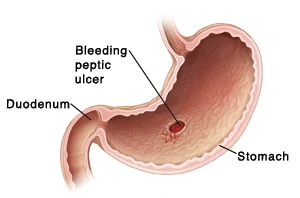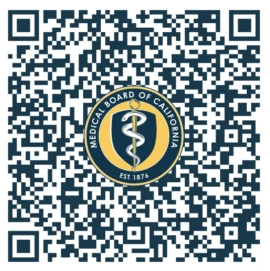You have a peptic ulcer. This is a sore in the lining of the stomach or duodenum (the first part of the small intestine). The ulcer is bleeding or at high risk of bleeding. This means that treatment is needed right away. Treatment can include medications and endoscopy or surgery. Your doctor will work with you to decide which treatments are best for you. Read on to learn more about each type of treatment.
Treatment With Medications

Medications will be prescribed as part of your treatment. These can include:
- Antibiotics. These kill Helicobacter pylori (H. pylori) bacteria if they are present. (H. pylori infection is the most common cause of a peptic ulcer.)
- Proton pump inhibitors. These block your stomach from making any acid.
- H2 blockers. These reduce the amount of acid your stomach makes.
- Bismuth subsalicylate. This helps protect the lining of your stomach and duodenum from acid.
When taking medications, be aware of the following:
- Each medication has risks and side effects. Your doctor will tell you more about these based on which medications are prescribed for you.
- Treatment with antibiotics lasts about 7 to 14 days. Other types of medications may need to be taken longer. Be sure to take all of the medications exactly as instructed. Do not stop taking the medications even if you are feeling better.
- During treatment, avoid non-steroidal anti-inflammatory drugs (NSAIDs) such as aspirin and ibuprofen. Overuse of these drugs is another possible cause of ulcers. Using them can worsen your symptoms.
- Your doctor may also advise you to avoid cigarettes, alcohol, and caffeine. These may worsen your symptoms. They may also affect how well your ulcer heals.
Treatment With Endoscopy or Surgery
Along with medications, your treatment may include endoscopy or surgery. Here’s what to expect with either treatment:
- Before the treatment. You may be told not to eat or drink anything for at least 6 hours before the treatment. Also, you’ll have to stop taking medications such as aspirin and other NSAIDs.
- During the treatment. A needle is placed in a vein in your hand or arm. It’s attached to a tube called an intravenous (IV) line. The IV line gives you fluids. It’s also used to give medication to prevent pain. This may include a sedative or anesthesia. Depending on the medication used, you may be drowsy or asleep during the treatment. The doctor will then treat your ulcer with one of the following:
- Endoscopy. With this procedure, a thin, flexible tube (endoscope or “scope”) is used. The scope has a tiny camera on the end. This allows the doctor to locate the ulcer. First, the throat is numbed with a spray or gargle. Then, the scope is inserted into the mouth and guided down into the stomach or duodenum. Air is used to expand the digestive tract. Once the ulcer is located, tools are passed through the scope to stop any bleeding. These may include clips or devices that use heat or electricity. In some cases, alcohol or adrenaline (epinephrine) is injected directly into the ulcer to help reduce bleeding. When the bleeding is stopped, the air is removed. The scope and any tools used are then also removed.
- Surgery. Surgery can be done in different ways. With open surgery, an incision is made in the abdomen to reach the ulcer. This allows the surgeon to view and treat the ulcer directly. With laparoscopy, a few small incisions are made in the abdomen. A scope with a tiny camera is then inserted through one of the incisions. Pictures of the inside of the abdomen are sent to a screen. This allows the doctor to locate the ulcer. Tools are then passed through the other incisions to treat the ulcer. Nearby nerves, blood vessels, and parts of the stomach may also be treated. Once the surgery is complete, the incisions are closed. Any tools used are removed.
- After the treatment. You’ll be taken to a recovery room or intensive care unit. Nurses will monitor your condition. You’ll be moved to a hospital room when you’re stable. Medications are given to help manage pain and to relieve symptoms. Tests may be done to check for bleeding or rebleeding of the ulcer. You’ll remain in the hospital until your doctor confirms there are no issues of concern. Before leaving the hospital, make sure you have all the prescriptions and home care instructions you’ll need. Also, make sure you have a contact number for your doctor or hospital. This is in case you have problems or questions after treatment.
Risks and Possible Complications of Endoscopy or Surgery
For endoscopy:
- Bleeding
- Perforation (a hole) in the upper digestive tract, which includes the esophagus, stomach, and duodenum
- Risks of sedative or anesthesia used
For surgery:
- Bleeding
- Infection
- Damage to nearby organs and blood vessels
- Long-term digestive problems such as irregular bowel movements
- Risks of anesthesia
- Death
Follow-Up
Keep all follow-up appointments with your doctor. These are needed to check your health and recovery progress.
When to Call the Doctor
Call the doctor right away if you have any of the following:
- Trouble breathing or chest pain (call 911)
- Fever of 100.4°F or higher
- Increased redness, pain, swelling, bleeding, or drainage from any incisions
- Trouble swallowing or sore throat that doesn't go away within 2 days
- Abdominal pain that won't go away
- Black, tarry, or bloody stools
- Nausea and vomiting


